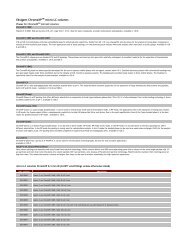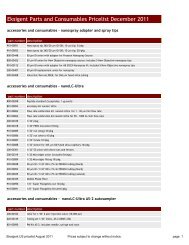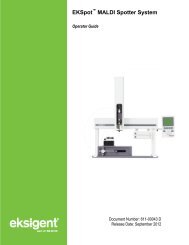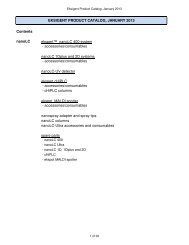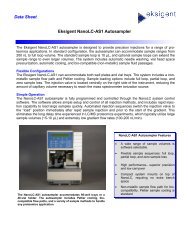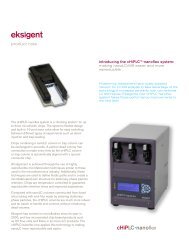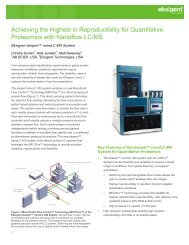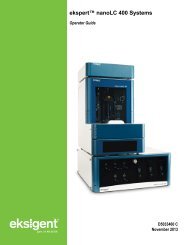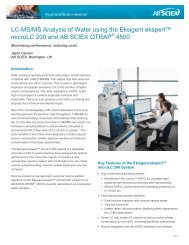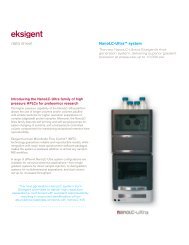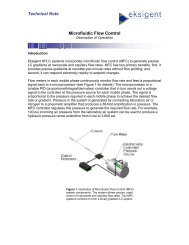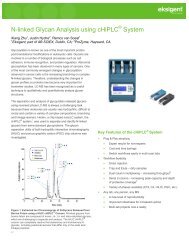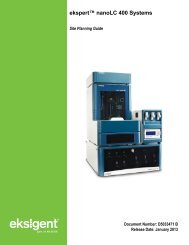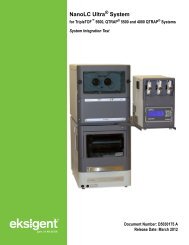NanoLC 1D Plus and 2D System Operator's Manual - Eksigent
NanoLC 1D Plus and 2D System Operator's Manual - Eksigent
NanoLC 1D Plus and 2D System Operator's Manual - Eksigent
- No tags were found...
You also want an ePaper? Increase the reach of your titles
YUMPU automatically turns print PDFs into web optimized ePapers that Google loves.
66 Operator’s <strong>Manual</strong>B.3.1 Other AutosamplersThe nanoLC can be integrated with autosamplers from other vendors through the use of contactclosures. A variety of configurations are possible using the inputs <strong>and</strong> outputs of the nanoLC describedabove. One suggested configuration is described here.Setup up the injection method <strong>and</strong> sample sequence using the autosampler interface (front panel orother software). Setup a matching sequence of chromatographic methods in the Run Manager of thenanoLC. Also make sure that LC Wait for Contact Closure is checked under the <strong>System</strong> menu in theRun Manager Window. Make sure that the analysis time per sample (time between autosamplerinjections) in the autosampler method is long enough to allow for the nanoLC method run time plus anypre-run flush equilibration for the next run.Connect the inject marker out from the autosampler to the Run Input (pin 8) <strong>and</strong> Ground (pin 7) of thenanoLC. Start the sequence by starting the Run Manager sequence <strong>and</strong> then the autosampler. After theautosampler initiates its own sequence for dispensing sample it will trigger the nanoLC to start itschromatographic run.The nanoLC also provides a Ready Out (pin 5) which can be used as an input to other autosamplers tosynchronize runs <strong>and</strong> error check operation.Note: The optimized injection routines that can be utilized with the nanoLC Autosampler will, ingeneral, not be available with other autosamplers. While the rapid inject or metered injection routinesof the nanoLC method can be used to increase the flow rate during sample loading, one will not beable to switch the sample loop out of the flow path during the gradient. The may lead to significantlyincreased gradient delay times <strong>and</strong> decreased response times of the system.B.3.2 Triggering MS Data CollectionWhile integrated control of the nanoLC system through the Xcalibur <strong>and</strong> Analyst software packages willbe available, most MS systems will allow synchronization of data collection through the use of contactclosures. The following describes the general configuration for this synchronization.In the MS software package, choose the option to start data collection with an external contact closure.This can be applied for a single MS run or to a sequence or batch of data collection methods. Whenconducting multiple runs in a sequence table, please configure the Run Manager of the nanoLCsoftware with the corresponding sequence of methods.Set the Run Output configuration to contact closure (box checked) in the nanoLC soft-ware (menu).One must then identify the hardware interface for the MS contact closure input. This is typically either aterminal block mounted on the side of the MS instrument, or a pair of wires in an interface cablesupplied with the MS.To synchronize MS data with the beginning of the gradient (after the injection), connect the Run Out(pin 3) <strong>and</strong> the Ground terminals to the MS contact closure. If one lead of the MS trigger is ground,make sure to connect it to the Ground connection of the nanoLC. For most applications, thisconnection will be made to the channel 2 (low flow gradient) side of the instrument.One can also choose to synchronize MS data with the beginning of the injection. To do this, connectthe Valve Out (pin 6) <strong>and</strong> the Ground terminals to the MS contact closure.nanoLC Operator’s <strong>Manual</strong> 611-00012 Revision A1



